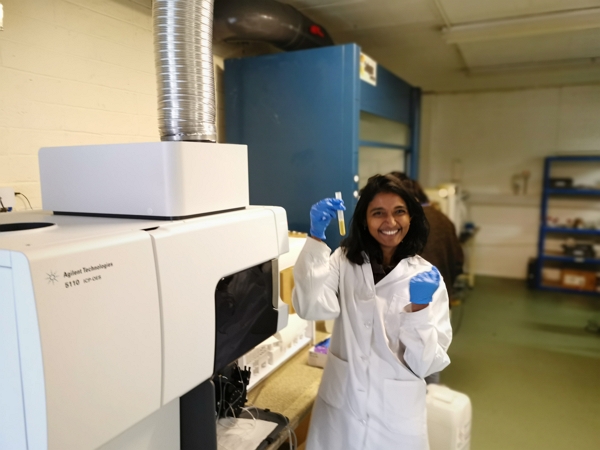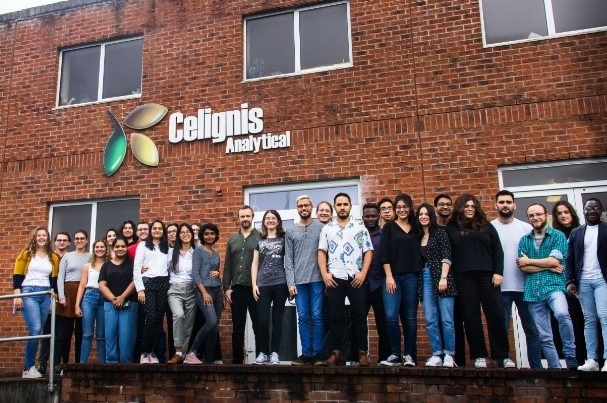Analysis of Carotenoids
Background
Carotenoids are a group of plant pigments responsible for bright red, yellow, and orange hues seen in many
fruits and vegetables. They are a class of phytonutrients, naturally occurring compounds that have beneficial
properties for human health.
Carotenoids are classified as terpenoids, specifically as tetraterpenoids (i.e. containing 8 isoprene units).
There are over 600 known carotenoids, but the most common ones include beta-carotene, lycopene, zeaxanthin, and lutein.
Carotenoids, which are typically divided into two main types: xanthophylls, which contain oxygen, and carotenes, which are purely hydrocarbons.
Carotenoids are classified as terpenoids, specifically as tetraterpenoids (i.e. containing 8 isoprene units).
There are over 600 known carotenoids, but the most common ones include beta-carotene, lycopene, zeaxanthin, and lutein.
Carotenoids, which are typically divided into two main types: xanthophylls, which contain oxygen, and carotenes, which are purely hydrocarbons.
Carotenoids are fat-soluble and are known for their antioxidant properties, helping to protect the body from damage by free radicals,
which are unstable molecules that can damage cells.
In addition to their antioxidant function, some carotenoids can be converted into vitamin A in the body, which is crucial for vision,
growth, and immune function.
Carotenoids have been linked to numerous health benefits when consumed as part of a balanced diet. They have been associated with reduced risk of certain types of cancers, improved eye health, and enhanced immune function. The wide array of colorful fruits and vegetables, such as carrots, tomatoes, sweet potatoes, and leafy greens, is a great source of carotenoids.
Carotenoids have been linked to numerous health benefits when consumed as part of a balanced diet. They have been associated with reduced risk of certain types of cancers, improved eye health, and enhanced immune function. The wide array of colorful fruits and vegetables, such as carrots, tomatoes, sweet potatoes, and leafy greens, is a great source of carotenoids.
Carotenoids in Different Types of Biomass
Examples of some carotenoids found in herbal leaf extracts are listed below:
Get more info...Herbal Leaf Extracts
- Beta-Carotene - found in various green leafy vegetables and herbs.
- Lutein and Zeaxanthin - These carotenoids are typically found together and are especially abundant in dark green leafy vegetables like spinach and kale.
- Lycopene - While lycopene is more commonly associated with red fruits and vegetables, particularly tomatoes, some herbs also contain this antioxidant carotenoid.
- Astaxanthin - This carotenoid is most commonly found in algae and seafood like salmon and shrimp, but it can also be found in some herbal extracts.
- Beta-Cryptoxanthin - Another pro-vitamin A carotenoid like beta-carotene, beta-cryptoxanthin can also be found in certain herbal leaf extracts.
Get more info...Herbal Leaf Extracts
Examples of some carotenoids found in flowers are listed below:
Get more info...Flowers
- Beta-Carotene - The most common type of carotenoid, it is often found in bright orange flowers. For example, marigolds (Tagetes spp.) are a common flower that contains high amounts of beta-carotene. Beta-carotene is a precursor to Vitamin A and acts as an antioxidant in the body.
- Lycopene - This carotenoid produces a red color and is most commonly found in tomatoes, but it is also present in some flowers, like certain species of roses. Lycopene has been linked to heart health and cancer prevention.
- Lutein and Zeaxanthin - These carotenoids are typically found together and contribute to yellow pigmentation. They are commonly found in flowers like calendula (Calendula officinalis). Both lutein and zeaxanthin are known for their antioxidant properties and their role in eye health.
- Astaxanthin - This carotenoid produces a reddish pigment and, while typically found in algae and aquatic animals that eat these algae, it may also be found in certain flowers. Astaxanthin has powerful antioxidant properties and is known for its potential benefits to skin health and inflammation reduction.
- Violaxanthin - This is a yellow pigment found in a variety of flowers, including pansies (Viola spp.) and some daisies (Bellis perennis). Like other carotenoids, violaxanthin has antioxidant properties.
- Capsanthin - This is a red pigment found in the flowers of certain pepper plants (Capsicum annuum).
Get more info...Flowers
Examples of some carotenoids found in fruit and vegetables are listed below:
Get more info...Fruit & Veg
- Beta-Carotene - This is the most common type of carotenoid and the most well-known provitamin A carotenoid. It gives carrots, sweet potatoes, spinach, and kale their orange or dark green colour.
- Alpha-Carotene - Similar to beta-carotene, alpha-carotene is also a provitamin A carotenoid. It is found in similar foods to beta-carotene, including carrots, pumpkins, and winter squashes.
- Lutein and Zeaxanthin - These carotenoids are found in colourful foods like corn and oranges. Lutein and zeaxanthin are beneficial for eye health and are the only carotenoids found in high concentrations in the retina of the eye.
- Lycopene - Known for giving tomatoes their red colour, lycopene is also found in watermelons, pink grapefruits, and apricots. It is a powerful antioxidant and has been linked to heart health and cancer prevention.
- Beta-Cryptoxanthin - Another provitamin A carotenoid, beta-cryptoxanthin, gives oranges, papayas, and peaches their orange colour.
Get more info...Fruit & Veg
Examples of some carotenoids found in brown seaweed are listed below:
Get more info...Brown Seaweed
- Fucoxanthin - This is the dominant carotenoid in brown seaweeds. It is a xanthophyll, known for its potential health benefits such as anti-inflammatory, antioxidant, and anti-obesity effects.
- Violaxanthin - This is another type of xanthophyll that can be found in some species of brown seaweed. Violaxanthin is part of the xanthophyll cycle, which is involved in the protection against photo-oxidative damage.
- Neoxanthin - This is a xanthophyll that can also be found in some brown seaweeds. It also plays a role in the xanthophyll cycle.
- Beta Carotene - This is a precursor of vitamin A that is present in many fruits and vegetables, as well as some types of seaweed.
- Lutein and Zeaxanthin - These carotenoids are typically found together and are present in some brown seaweeds.They are known for their antioxidant properties and their role in eye health.
- Lycopene - While lycopene is more commonly associated with red fruits and vegetables, particularly tomatoes, it can also be found in some brown seaweed species.
Get more info...Brown Seaweed
Examples of some carotenoids found in green seaweed are listed below:
Get more info...Green Seaweed
- Beta Carotene - This carotenoid, with antioxidant bioactive properties, is found in green seaweed species such as Ulva lactuca (sea lettuce) and Codium fragile (commonly known as green sea fingers or dead man's fingers).
- Lutein - This is a powerful antioxidantand that can play a role in maintaining eye health. It is found in Ulva lactuca and Caulerpa lentillifera (often known as "sea grapes" or "green caviar").
- Violaxanthin - Found in Ulva lactuca and Enteromorpha intestinalis.
- Neoxanthin - This carotenoid has antioxidant properties and is involved in the process of photosynthesis. It is found in Ulva lactuca and Caulerpa lentillifera.
- Zeaxanthin - Like lutein, zeaxanthin plays a crucial role in eye health. It is also involved in the xanthophyll cycle and offers protection against harmful high-energy blue light. It is found in Ulva lactuca and Enteromorpha intestinalis.
- Siphonaxanthin - This is a unique xanthophyll found in green seaweeds (e.g. Codium fragile) and some red seaweeds.
- Siphonein - This carotenoid is specifically found in siphonous green algae, like Bryopsis, and some red seaweeds.
Get more info...Green Seaweed
Examples of some carotenoids found in red seaweed are listed below:
Get more info...Red Seaweed
- Zeaxanthin - This carotenoid is also common in red seaweeds. For instance, the red seaweed Chondrus crispus, commonly known as Irish moss, contains zeaxanthin.
- Lutein - This carotenoid is less common in red algae compared to other types of seaweed, however an example of a red seaweed that does contain lutein is Porphyra species (known as Nori).
- Bet-Carotene - This carotenoid is widely distributed in many organisms and is present in a number of red seaweed species, for instance Palmaria palmata (known as dulse).
- Siphonaxanthin - This is a unique xanthophyll found in green seaweeds (Chlorophyta) and some red seaweeds.
- Siphonein - This carotenoid is specifically found in siphonous green algae, like Bryopsis, and some red seaweeds.
Get more info...Red Seaweed
Extraction of Carotenoids from Biomass
The extraction process, including the solvents and methods used, can influence the concentration and types of carotenoids present in the final extract.
It is often the case that a balance needs to be found between fully-extracting all carotenoids while also ensuring that the compounds that are
obtained are of a high quality and not degraded.
At Celignis we have extensive experience in the design and optimisation of extraction protocols for a wide variety of chemical constituents from many different biomass types. If needed we can also work on processes to separate and purify the target compounds.
Click here to read more about Celignis's Bioprocess Development Services for the extraction of chemicals from biomass.
Get more info...Biomass Extractions
At Celignis we have extensive experience in the design and optimisation of extraction protocols for a wide variety of chemical constituents from many different biomass types. If needed we can also work on processes to separate and purify the target compounds.
Click here to read more about Celignis's Bioprocess Development Services for the extraction of chemicals from biomass.
Get more info...Biomass Extractions
Analysis of Carotenoids at Celignis
We have the necessary equipment and expertise to determine the amount and distribution of carotenoids in
a wide variety of biomass samples.
Feel free to get in touch with us to request further information and a quotation.
Below are listed the different Celignis analysis packages that determine carotenoids.
Request a QuoteCarotenoids Analysis
Feel free to get in touch with us to request further information and a quotation.
Below are listed the different Celignis analysis packages that determine carotenoids.
Request a QuoteCarotenoids Analysis








